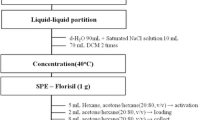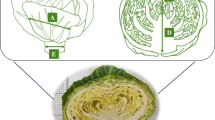Abstract
In this study, the dissipation pattern of the fungicide in green mustard and soil was studied through field trials experiments conducted under the net house and open field in wet and dry seasons. Field trial results were then compared with data collected from laboratory trials conducted under controlled conditions. Chlorothalonil residue showed 99.5–99.7% loss in the dry season while in the wet season the residue loss was 94.37–99.8% under the net house and open field, respectively. The half-life of chlorothalonil in the green mustard planted in the net house and open field were 1.03 and 0.86 days in the dry season, while in the wet season, it was 2.21 and 2.02 days. The terminal residue of chlorothalonil exceeded the Maximum Residue Limit of 0.01 mg kg−1, which violates the National Food Act 1983 and food safety regulation. This work is significant in the agriculture sector to provide a better insight into pesticides fate and establish the correct pre-harvest intervals for chlorothalonil on green mustard, thus reducing the pesticide toxicity effect among consumers.






Similar content being viewed by others
References
Velásquez AC, Castroverde CDM, He SY (2018) Plant–pathogen warfare under changing climate conditions. Curr Biol 28:R619–R634. https://doi.org/10.1016/j.cub.2018.03.054
Wahi R, Bidin ER, Mohamed Asif NM et al (2019) Nutrient availability in sago bark and empty fruit bunch composts for the growth of water spinach and green mustard. Environ Sci Pollut Res 26(22):22246–22253. https://doi.org/10.1007/s11356-019-05548-6
Reyna PB, Albá ML, Rodríguez FA et al (2021) What does the freshwater clam, Corbicula largillierti, have to tell us about chlorothalonil effects? Ecotoxicol Environ Saf 208:111603. https://doi.org/10.1016/j.ecoenv.2020.111603
Yang G, Wang Y, Li J et al (2021) Health risks of chlorothalonil, carbendazim, prochloraz, their binary and ternary mixtures on embryonic and larval zebrafish based on metabolomics analysis. J Hazard Mater 404:124240. https://doi.org/10.1016/j.jhazmat.2020.124240
Wang Z, Yang L, Cheng P et al (2021) Adsorption, degradation and leaching migration characteristics of chlorothalonil in different soils. Eur J Remote Sens 54:238–247. https://doi.org/10.1080/22797254.2020.1771216
Pedroso C, Dias-Neto JJ, Rossato M et al (2020) Managing sweet pepper anthracnose by choice of planting season, organic soil mulch, fungicide and moderate nitrogen fertilization. Phytoparasitica 48:525–533. https://doi.org/10.1007/s12600-020-00819-2
Zhang D, Tang J, Zhang G et al (2021) Deposition, dissipation, metabolism and dietary risk assessment of chlorothalonil in open field-planted cabbage. J Food Compos Anal 102:104008. https://doi.org/10.1016/j.jfca.2021.104008
Meng C, He Q, Huang J-W et al (2015) Degradation of chlorothalonil through a hydrolytic dehalogenase secreted from Bacillus subtilis WB800. Int Biodeterior Biodegrad 104:97–104. https://doi.org/10.1016/j.ibiod.2015.05.017
Seloma A, Shalaby A (2021) Effect of water pH and direct exposure to sunlight on chemical stability of fungicide chlorothalonil. J Plant Prot Pathol 12:543–548. https://doi.org/10.21608/jppp.2021.198243
Leistra M, van den Berg F (2007) Volatilization of parathion and chlorothalonil from a potato crop simulated by the PEARL model. Environ Sci Technol 41:2243–2248. https://doi.org/10.1021/es0627242
Monadjemi S, El Roz M, Richard C, Ter Halle A (2011) Photoreduction of chlorothalonil fungicide on plant leaf models. Environ Sci Technol 45:9582–9589. https://doi.org/10.1021/es202400s
Yang X, Zhang G, Wang F et al (2015) Development of a colloidal gold-based strip test for the detection of chlorothalonil residues in cucumber. Food Agric Immunol 26:729–737. https://doi.org/10.1080/09540105.2015.1018875
Pant U, Bhajan R, Singh A et al (2020) Green leafy mustard: a healthy alternative. Electron J Plant Breed 11:267–270. https://doi.org/10.37992/2020.1101.045
Yadav RC, Singh D, Rani A et al (2018) Development of Alternaria blight resistant lines through interspecific hybridization between Indian mustard (Brassica juncea L.) and white mustard (Brassica alba) through embryo rescue. J Oilseed Brassica 9:104–113
Chai L-K, Mohd-Tahir N, Bruun Hansen HC (2009) Dissipation of acephate, chlorpyrifos, cypermethrin and their metabolites in a humid-tropical vegetable production system: dissipation of insecticides in a tropical vegetable system. Pest Manag Sci 65:189–196. https://doi.org/10.1002/ps.1667
Du P, Wu X, He H et al (2017) Evaluation of the safe use and dietary risk of beta-cypermethrin, pyriproxyfen, avermectin, diflubenzuron and chlorothalonil in button mushroom. Sci Rep 7:8694. https://doi.org/10.1038/s41598-017-07860-y
Gambacorta G, Faccia M, Lamacchia C et al (2005) Pesticide residues in tomato grown in open field. Food Control 16:629–632. https://doi.org/10.1016/j.foodcont.2004.07.002
Jankowska M, Kaczynski P, Hrynko I, Lozowicka B (2016) Dissipation of six fungicides in greenhouse-grown tomatoes with processing and health risk. Environ Sci Pollut Res 23:11885–11900. https://doi.org/10.1007/s11356-016-6260-x
Ramírez-Bustos II, Saldarriaga-Noreña H, Fernández-Herrera E et al (2019) Dissipation behavior of three pesticides in prickly pear (Opuntia ficus-indica (L.) Mill.) pads in Morelos, Mexico. Int J Environ Res Public Health 16:2922. https://doi.org/10.3390/ijerph16162922
Rahman MdM, Park J-H, Abd El-Aty AM et al (2013) Single-step modified QuEChERS for determination of chlorothalonil in shallot (Allium ascalonicum) using GC-μECD and confirmation via mass spectrometry: single-step QuEChERS for chlorothalonil determination. Biomed Chromatogr 27:416–421. https://doi.org/10.1002/bmc.2808
Kurz MHS, Gonçalves FF, Adaime MB et al (2008) A gas chromatographic method for the determination of the fungicide chlorothalonil in tomatoes and cucumbers and its application to dissipation studies in experimental greenhouses. J Braz Chem Soc 19:1129–1135. https://doi.org/10.1590/S0103-50532008000600012
Hou F, Zhao L, Liu F (2016) Residues and dissipation of chlorothalonil and azoxystrobin in cabbage under field conditions. Int J Environ Anal Chem 96:1105–1116. https://doi.org/10.1080/03067319.2016.1233969
Mahmoud HA, El-Hefny DE, Helmy RMA (2021) Environmental view for chlorothalonil on tomato and pepper fruits and soil field in Egypt: risk assessment and pre-harvest gap. Int J Environ Anal Chem 101:639–647. https://doi.org/10.1080/03067319.2019.1670823
Hwang J-I, Seok D-R, Kim J-E (2019) Effects of cuticular waxes on permeation of fungicides azoxystrobin and chlorothalonil into apples. Appl Biol Chem 62:34. https://doi.org/10.1186/s13765-019-0441-5
SANCO (2011) Guidance document on analytical quality control and validation procedures for pesticide residues analysis in food and feed. European commission health and consumer protection directorate-general
Chai L-K, Wong M-H, Mohd-Tahir N, Hansen HCB (2010) Degradation and mineralization kinetics of acephate in humid tropic soils of Malaysia. Chemosphere 79:434–440. https://doi.org/10.1016/j.chemosphere.2010.01.046
Chai L-K, Zaidel N-D, Hansen HCB (2012) A rapid multi-residue method for the determination of pesticide residues in choi sum, yardlong beans and aubergines. Food Chem 131:611–616. https://doi.org/10.1016/j.foodchem.2011.09.037p
Abdelkader A, Ayoub M, Mohammed A (2020) Evaluation of pesticide residues in some commonly consumed vegetables in Egypt and their related chronic exposure. Alfarama J Basic Appl Sci 2:149–167. https://doi.org/10.21608/ajbas.2020.43968.1035
Munawar N, Yang Farina YF, Yaqoob M et al (2021) Distribution of pesticides in different commonly grown vegetables of Cameron Highlands, Pahang, Malaysia. Sains Malays 50:2937–2944. https://doi.org/10.1757/jsm-2021-5010-08
Sapbamrer R, Hongsibsong S (2014) Organophosphorus pesticide residues in vegetables from farms, markets, and a supermarket around Kwan Phayao Lake of Northern Thailand. Arch Environ Contam Toxicol 67:60–67. https://doi.org/10.1007/s00244-014-0014-x
King KW, Balogh JC (2013) Event based analysis of chlorothalonil concentrations following application to managed turf. Environ Toxicol Chem 32:684–691. https://doi.org/10.1002/etc.2092
Zhang Z-Y, Liu X-J, Yu X-Y et al (2007) Pesticide residues in the spring cabbage (Brassica oleracea L. var. capitata) grown in open field. Food Control 18:723–730. https://doi.org/10.1016/j.foodcont.2006.04.001
Byamukama E, Ali S, Kleinjan J et al (2019) Winter wheat grain yield response to fungicide application is influenced by cultivar and rainfall. Plant Pathol J 35:63–70. https://doi.org/10.5423/PPJ.OA.04.2018.0056
Gao S, Liu Y, Jiang J et al (2019) Physicochemical properties and fungicidal activity of inclusion complexes of fungicide chlorothalonil with β-cyclodextrin and hydroxypropyl-β-cyclodextrin. J Mol Liq 293:111513. https://doi.org/10.1016/j.molliq.2019.111513
Omer SA, Fakhre NA (2019) Three different spectrophotometric methods for simultaneous determination of pyriproxyfen and chlorothalonil residues in cucumber and cabbage samples. J Spectrosc 2019:1–11. https://doi.org/10.1155/2019/8241625
Carlo-Rojas Z, Bello-Mendoza R, Figueroa MS, Sokolov MY (2004) Chlorothalonil degradation under anaerobic conditions in an agricultural tropical soil. Water Air Soil Pollut 151:397–409. https://doi.org/10.1023/B:WATE.0000009918.70113.c5
Schimmelpfennig D (2018) Crop production costs, profits, and ecosystem stewardship with precision agriculture. J Agric Appl Econ 50:81–103. https://doi.org/10.1017/aae.2017.23
Ciglasch H, Busche J, Amelung W et al (2006) Insecticide dissipation after repeated field application to a Northern Thailand Ultisol. J Agric Food Chem 54:8551–8559. https://doi.org/10.1021/jf061521u
Laabs V, Amelung W, Pinto AA et al (2002) Pesticides in surface water, sediment, and rainfall of the Northeastern Pantanal Basin, Brazil. J Environ Qual 31:1636–1648. https://doi.org/10.2134/jeq2002.1636
Kookana R, Holz G, Barnes C et al (2010) Impact of climatic and soil conditions on environmental fate of atrazine used under plantation forestry in Australia. J Environ Manag 91:2649–2656. https://doi.org/10.1016/j.jenvman.2010.07.037
Katayama A, Mori T, Kuwatsuka S (1995) Abiotic dissipation of chlorothalonil in soil accelerated by amendment with high applications of farmyard manure. Soil Biol Biochem 27:147–151. https://doi.org/10.1016/0038-0717(94)00156-U
Potter TL, Wauchope RD, Culbreath AK (2001) Accumulation and decay of chlorothalonil and selected metabolites in surface soil following foliar application to peanuts. Environ Sci Technol 35:2634–2639. https://doi.org/10.1021/es002054e
Hou F, Zhao L, Liu F (2016) Determination of chlorothalonil residue in cabbage by a modified QuEChERS-based extraction and gas chromatography–mass spectrometry. Food Anal Methods 9:656–663. https://doi.org/10.1007/s12161-015-0228-1
Acknowledgements
The authors would like to thank The Ministry of Higher Education Malaysia for financial support.
Funding
This work was supported by The Ministry of Higher Education through FRGS/ST01(02)/968/2013(09).
Author information
Authors and Affiliations
Corresponding authors
Ethics declarations
Conflict of interest
The authors declare that they have no competing interests.
Supplementary Information
Below is the link to the electronic supplementary material.
Rights and permissions
About this article
Cite this article
Ngaini, Z., Henry, M.C., Chai, LK. et al. Chlorothalonil Dissipation as Influenced by Growing Season and Cultivation Systems on Green Mustard and Soil. Chemistry Africa 5, 1127–1138 (2022). https://doi.org/10.1007/s42250-022-00384-7
Received:
Accepted:
Published:
Issue Date:
DOI: https://doi.org/10.1007/s42250-022-00384-7




